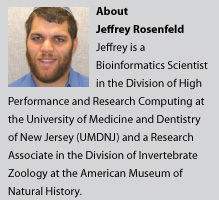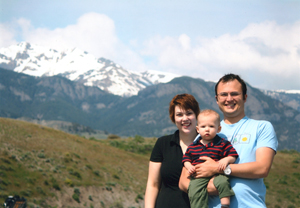In a recent GenomeWeb article by Tony Fong, “Sequenom’s CEO ‘Puzzled’ by Illumina’s Buy of Verinata, Lays out 2013 Goals at JP Morgan,” Harry Hixson, Sequenom’s CEO, expresses puzzlement over why its major supplier, Illumina, is acquiring a Sequenom competitor in Non-Invasive Prenatal Testing (NIPT), and thus apparently competing with one of its major customers. In a JP Morgan interview… Read more »
We are excited to let you know about new scripts to aid in filtering rows/columns and identifying unique values in a column, as well as two updated scripts. Don’t forget about the Technical Support Bulletins which keep you up-to-date on all the latest script news. You can stream this feed via an RSS reader, receive email updates, or see the… Read more »
As a senior studying statistics at Montana State University, I was fortunate to be granted the opportunity to intern with the development team at a local software company. I was even more fortunate when this internship turned into full-time employment after I graduated. Working on a team with extremely talented individuals, I realized the significant impact our company makes through… Read more »
Happy new year! We hope all of our readers, clients, and users had a great holiday season filled with friends and family! While Golden Helix did take a break from blogging in December, we’ve still been pretty busy bringing you new and exciting things. We’re pleased to announce the addition of genome maps and annotation tracks for two new plant… Read more »
After much anticipation, we are excited to announce that SVS 7.7 is available! It’s been a lot of work, but we are pleased with the result and know you will be too! SVS 7.7 includes: Improved RNA-Seq Analysis Package for mRNA Expression Profiling Import tabularized quantification data from the Golden Helix pipeline or other sources. Utilize DESeq to perform differential… Read more »
Golden Helix is proud to announce our participation in EA’s 2012 “Leave Your Fingerprint on the Cure.” This event will be taking place at ASHG 2012 in San Francisco at the Moscone Center on November 7th. The fifth annual “Leave Your Fingerprint on the Cure” was designed by EA to help raise money for researchers in their efforts to discover… Read more »
Dr. Folefac Aminkeng is a Postdoctoral Fellow at The Centre for Molecular Medicine and Therapeutics (CMMT) at the University of British Columbia in Vancouver, BC, Canada. He utilizes GWAS studies to identify single-nucleotide polymorphisms (SNPs) that might be associated with serious adverse drug reactions (ADRs) in cancer therapeutics. The field of pharmacogenomics—how one’s genetic makeup affects drug response—has grown exponentially… Read more »
Since Dr. Ken Kaufman gave his webcast on Identifying Candidate Functional Polymorphisms in SVS, we’ve been working with Dr. Kaufman to simplify and automate many of the steps in his workflow. I touched on this in my last blog post, and I’m excited to report that with Ken’s help, we’ve been able to simplify the workflow even more. In particular… Read more »
Editor’s Note by Gabe Rudy: I’ve had the chance to exchange thoughts, emails, and blog post comments for a while now with Jeff as he has written posts on NGS Leaders and engaged with me on 23andMe. He has also worked with Golden Helix software as part of Dr. Todd Lencz’s research efforts at Zucker Hillside Hospital until he recently… Read more »
Golden Helix announced it would offer a complimentary genome browser for visualizing DNA and RNA-Seq data back in October of 2011; however no release date was disclosed at that time. Well, after much blood, sweat, and tears, we are VERY excited to announce that GenomeBrowseTM is here! GenomeBrowse raises the bar on the on the experience of exploring and finding… Read more »
Dr. Ken Kaufman’s extremely popular webinar inspired us to build new tools that would simplify the process of analyzing whole-exome DNA sequencing data even further. First I’ll describe the tools showcased in the webcast. Then I’ll detail the new tools we created to allow for a revised and simplified workflow. Subset Informative Genotypes by Category The Subset Informative Genotypes by… Read more »
Dr. Peter K. Gregersen, head of the Robert S. Boas Center for Genomics and Human Genetics at the Feinstein Institute for Medical Research, utilizes GWAS, targeted arrays, and sequencing technologies to identify genes associated with human autoimmune disorders. The arrival of the GWAS platform in the mid-2000’s greatly accelerated the pace of gene discovery—as well as accelerating the number of… Read more »
What prevents scientists from being more productive and if we knew, could we do anything about it? I’d like to look at an often overlooked, but huge productivity inhibitor — bad multitasking. Many people put “excellent multitasker” on their resume as a badge of honor. We laud the efficiency of a good multitasker — they are rarely idle — someone… Read more »
After my latest blog post, Jeffrey Rosenfeld reached out to me. Jeff is a member of the Analysis Group of the 1000 Genomes Project and shared some fascinating insights that I got permission to share here: Hi Gabe, I saw your great blog post about the problems in the lack of overlap between Complete Genomics and 1000 Genomes data. I… Read more »
Thank you to everyone who joined us yesterday for a webcast by Dr. Ken Kaufman of Cincinnati Children’s Hospital: “Identification of Candidate Functional Polymorphism Using Trio Family Whole Exome DNA Data.” Over 750 people registered for this event and 430 attended – a new Golden Helix record! If you missed the webcast (or would like to watch it again), the… Read more »
Last month I was inspired to create a new way to keep our customers apprised of the latest information on Golden Helix software without cluttering inboxes and overwhelming our blog. I happened to receive a link to an article for one of Illumina’s bulletins and realized that was exactly what we needed at Golden Helix as well! On Wednesday, we… Read more »
There is nothing cooler than having something arrive that you have been excitedly waiting for: last week I got an email notification that my 23andMe exome results were ready. Actually, I got 3 emails that my exome results were ready. You see, I lucked out. It all began two years ago on DNA day when Hacker News reported that 23andMe… Read more »
SVS 7.6.7 features new tools for filtering sequencing data based on functional predictions and allele frequencies. To complement these new features, new annotations tracks have been uploaded to our data server and are now available for our customers! Below you will find descriptions of the new tools and the related annotations track(s).
Dr. John Curtin is a Lecturer in Functional Genomics at the University of Manchester where he works with a large team studying the development of asthma in a birth cohort. This group has received data on study subjects periodically for over a decade including before birth. Given how much data there is, data management is a big deal to Dr…. Read more »
Recently I gave a presentation on bioinformatic filtering: the process of using quality scores, annotation databases, and functional prediction scores to intelligently and quickly reduce your variant search space. In this webcast, I mention that filtering is something we have been doing for a long time, and that there are some great examples that use exome sequencing data along with… Read more »







